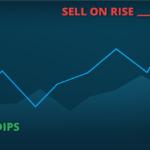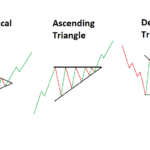There are two types of company bankruptcy. The first is where the company stops all operations and goes out of business, completely. In the United States, this is called Chapter 7.
The other kind is where the company is given time to restructure debts, which have become unmanageable. In the United States, this is called Chapter 11.
When a company has been given time to restructure its debts, a committee is formed that decides if a reorganization of debt is possible. Stockholders are represented but they do not have a say in the plan.
The company still runs normally during Chapter 11, but stocks and shares are not publically traded. Hence, assessing their real value is difficult and their price could drop substantially on the mere suspicion that the company is going to file.
If the committee decides that reorganization of debt is not viable, the company stops trading. However, if the company emerges from Chapter 11, stock prices will rise on the hope that the newly reorganized company will be a stronger company in the future.
What happens to stocks in bankruptcy
When a company stops trading, its assets are used to pay the company’s debtors. Shareholders are entitled to a share of the assets that have been liquidated, depending on whether anything is left over after paying off debts.
The stock that the stockholders hold becomes worthless and of course untradeable. The only hope the stockholders have is that there are enough liquidated assets to pay them for their shares.
When the company sells off its assets to pay its debts there is an order in which the debts have to be paid. The order is:
- secured creditors,
- unsecured creditors,
- preferred shareholders,
- common shareholders.
Secured and unsecured creditors are institutions to whom the company owes money, such as governments, banks, and utilities. The shareholders are last to be paid with the preferred shareholders paid before the common shareholders if there are any liquid assets left.
The reason for this is that common shareholders have voting rights and, as such, are considered to bear some responsibility for the company’s predicament.
The money a shareholder will receive is always based on the proportion of ownership the shareholder has in the company.
For example, if the shareholders’ marketA location or entity where people and entities can negotiate and trade assets of value. share is 1% of the company and the available liquid money to pay its shareholders is $200,000, a single shareholder will receive $2,000.
In Conclusion
If a company you have shares in files for bankruptcy the chances that you will be 100% compensated for the full value of your stock are virtually nil. In all probability, you will only get back pennies on the dollar.
As a potential investor in a company, it is therefore prudent to take into account the possibility of the company going bankrupt, and you should analyse such ratios as debt to equity and book value to get an idea of what you might receive if such a case.











